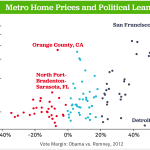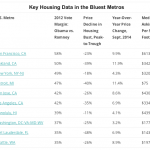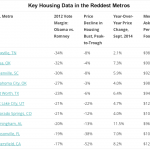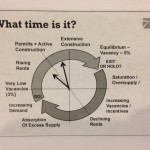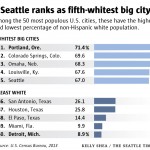Housing on the Seattle Channel
While you were all out trick or treating, the Seattle Channel aired this great discussion on affordable housing. In the world of television, 30 minutes is an eternity; but the housing discussion needs more time. Still, we got a lot of good discussion in, and this program advanced the importance of the issue. My point: we need to do this together, not by taxing new people moving to our city.
How Liberals Make Life Worse for the Poor
I was sent two articles (one in The Atlantic the other in Bloomberg View) this last week about the fact that in the United States that more liberal and progressive cities usually have very expensive housing, so expensive that it can be linked to greater income inequality between the have’s and the have-nots in a city. The data and charts that have started the discussion were originally written about at Trulia, a real estate site. In that post, the author looked at election data from the 2012 election and relative housing prices in a number of cities in the United States:
Here’s two more charts from that post that look at price, per square foot, for housing in red and blue cities.
The author then asks what we all want to know:
What does all this mean? The point is not that Democrats cause expensive housing, lower homeownership, or greater inequality. Determining whether and how the political views of voters or their elected officials affect local housing markets is the stuff of scholarly research, not short blogposts. But because blue markets are less affordable, have lower homeownership, and have greater income inequality, political leaders in Democratic-leaning and Republican-leaning metros may push for different policies.
How does this work in blue cities? Megan McArdle, author of the post in Bloomberg View has lays it out pretty well:
Consider, too, that the liberal base is composed of a large number of small interest groups with a long and successful history of lobbying government for laws. Those groups have paid a lot of attention to enabling this sort of action, making sure that their local political institutions have lots of avenues by which small groups can affect the legislative process. Everything has extensive community review, and it’s easy for local groups to file lawsuits that block some undesirable project.
So when a local developer proposes to, say, build a huge housing project down the street, every neighborhood is well supplied with folks who have organizing experience and know how to lobby against something they don’t like. Those organizers have a lot of tools to fight with.
Liberals are very good at “taking it to the streets” when they don’t like something, and in cities like Seattle that could mean marraige inequality or the microhousing project down the street. Filling rooms with angry people, aggrieved about an issue is a liberal organizing trademark. The problem, however, is that in most cases in Seattle, the angry people are single family homeowners pressuring elected officials to enact policies that will constrict housing supply driving up rents for people moving to the city.
Derek Thompson, author of the post in The Atlantic quotes economist Matthew Kahn:
I asked Kahn if he had a pet theory for why liberals, who tend to be vocal about income inequality, would be more averse to new housing development, which would help lower-income families. He suggested that it could be the result of good intentions gone bad.
“Developers pursue their own self-interest,” Kahn said. “If a developer has an acre, and he thinks it should be a shopping mall, he won’t think about neighborhood charm, or historic continuity. Liberals might say that the developer acting in his own self-interest ignores certain externalities, and they’ll apply restrictions. But these restrictions [e.g. historic preservation, environmental preservation, and height ceilings] add up, across a city, even if they’re well-intentioned. The affordability issue will rear its head.”
The idea that enough data and planning can create policies that will create a certain outcome, including good design and low prices, simply ignores economic reality. But when backed with the same organizing tactics used to support civil rights, for example, that economic reality gets exchanged for a political one, and policies that are inflationary get enacted in the name of lowering prices. It’s a trend Seattle still has a chance to buck. Unless we do, we’re dooming people with less money to compete with wealthier people for rental housing, a competition they are sure to lose.
Supply and Demand Clock: What Time is it?
I am presenting at a Continuing Legal Education Seminar hosted by The Seminar Group today. The chair of the seminar is Blaine Weber from Weber Thompson Architects. He kicked off the seminar with one of the best charts illustrating supply and demand I’ve ever seen. It’s the featured image above, but here it is again:
This is really how it works. The people in this seminar make decisions about money, lots of money, based on this cycle. That’s why they’re here, to help their customers and clients make decisions about the future of development in the city of Seattle and our region. Weber says it’s about 10 o’clock on the supply and demand clock. You can see what happens next; equilibrium, saturation, vacancies, and then declining rents.
Supply and demand is a real thing taken for granted by people who build. Policy makers regard it as something of a novelty, and some, like Counclmember Sally Clark, actually think this idea, supply and demand, doesn’t apply to housing:
“The argument is that if there are enough cans of Pepsi, the price of Pepsi will come down,” Clark says. “It may work for Pepsi, but not for housing.” She and others point to Ballard as an example of the failed maximum-density theory, where rental rates (and vacancies) are at a citywide high despite increased supply.
One doesn’t need to look too much more for a reason why our city leaders can’t figure out how to solve the housing problem. They need to figure out what time it is: it’s time to build more housing!
Seattle: Whiteness, Taxes, Prices Up, Diversity Down
There are two seemingly unrelated items in yesterday’s online Seattle Times. First, FYI Guy’s post about the relative whiteness of Seattle compared to other comparable cities in the United States:
Seattle’s “whitening” doesn’t buck just the national trend. It also runs counter to what’s happening in King County as a whole. Outside of Seattle, the county’s white population decreased by 13,500, and now stands at 61.1 percent of the total — a drop of nearly two percentage points in one year.
FYI Guy isn’t willing to hazard a guess about why this is happening in Seattle. But I am. It’s pretty simple, lack of housing supply for families. Part of what’s happening here is that it’s getting harder and harder to find housing in Seattle for families with children. While that family demographic is diversifying it is also running into a wall of high prices and inappropriate typologies. Families of color are like most families, but there are more families of color now than in the past. So, those families are having to live elsewhere. As we’ve pointed out, the best way to get the city to be diverse is to build more housing and increase housing choices!
But Councilmember O’Brien’s solution is to tax new housing as a way to subsidize housing that people can afford. His idea won’t work because it will simply increase the costs associated with housing. A view that the Seattle Times editorial board shares. Here’s what they wrote yesterday:
In reality, increasing the cost of producing homes could stop some projects from getting built, thus limiting supply and pushing prices higher over time. Prices keep going up because residents are competing with each other for the available housing stock and the city has a limited supply of land.
Rising housing demand stems directly from a boom of new jobs and residents.
Nonetheless, the majority of the City Council has painted new development as a culprit in pricing out people on the lower end of the economic spectrum and that a linkage fee is just one way to get developers to pay their fair share.
Add to this that Councilmember O’Brien wants to use the money he gets from the linkage tax to fund housing for people who earn 60 to 80 percent of Area Median Income (AMI), a level of income that doesn’t need any help with housing.
Councilmember O’Brien casts himself as a champion of social justice, but what he’s really doing is reversing a positive trend of housing construction that is actually creating stable prices for people who earn 60 to 80 percent of AMI and doing nothing for the families of color who are choosing today to live outside the city, either because of price or lack of the right kind of housing or both. Also, it’s important to note that programs like the Multifamily Tax Exemption are creating thousands of units prices for people earning 60 to 80 percent AMI, units that are integrated into market rate buildings.
Yesterday’s Seattle Times shows pretty clearly that impartial observers who aren’t trying to pad their political resumes, play Robin Hood, or ensure their own re-election get it: our city isn’t diversifying, and driving up housing prices by adding costly taxes will only make that worse.
Is Seattle Down for the Count on Affordable Housing?
Recently I have begun to envision Seattle housing affordability personified as an overmatched, undersized boxer who has gotten knocked down time and time again, but through sheer grit, courage and resolve continues to get up off the mat and keep fighting. The repeated knock downs represent the series of beatings Seattle housing has taken in the past year, in this particular order: 2013’s small-lot legislation (which cemented single-family neighborhoods as untouchable), 2014’s microhousing legislation (touted as a “compromise” even though it will make new units more expensive), the new linkage fee legislation, and to cap it all off, Sally Clark’s low-rise downzone proposal. Each of those four changes make things worse for housing affordability. The microhousing and linkage fee laws add costs to new developments. This has the double whammy effect of instantly adding to renters’ costs, but also discouraging new development, which adds more costs again by reducing supply and increasing competition over a scarce product. But there is still a fighting chance for Seattle to get back up and be a winner on housing affordability.
The small-lot and low-rise downzone laws skip straight to discouraging development. You feel like you are taking crazy pills when you hear the Council say that this is all in the name of affordability. But the pieces of the puzzle start to come together when you remember that last year we voted to create district elections, where council members will be voted in by their district constituents instead of by the city-at-large. Like gerrymandering, this has the effect of splintering the voting power of urbanists, and giving single-family neighborhoods more power. As such, the Council has done a housing 180 to protect their political careers.
The boxing metaphor I have in my head ends with the boxer getting up off the mat. Housing affordability in Seattle can get up too. We must not resign ourselves to letting Seattle become San Francisco – a gated community for the rich. Today, we must be optimists. Even in this crazy climate, there are signs of hope: Mayor Murray’s housing affordability has a chance to lead to positive outcomes (I am particularly glad to see Alan Durning of Sightline Daily is on the committee). Sally Clark has hinted that maybe, just maybe, it’s silly to keep 65% of the city off-limits to development. And prior to his linkage fee push, Mike O’Brien suggested he wanted to make the land-use code friendlier to Accessory Dwelling Units (ADU’s). An optimist might even say that now is a better time than ever to lay the ground work for a paradigm-shifting housing discussion while we wait for next year’s district elections to come and go. Because once the elections are over, there is a chance a more reasonable discussion about things like up-zoning can take place. So let’s talk about it.
The concept I am most intrigued by is the idea of “gentle density”. This is a coin termed by Vancouver-based urbanist, planner, and overall awesome-guy-I-wish-was-in-Seattle, Bren Toderian. Toderian, and his consultant company, Toderian UrbanWORKS, have given a new name to a very old and successful concept: density done well. What is gentle density, and why is it crucial for Seattle? Gentle density is density that blends in, fits the scale of its surroundings, and best of all, is capable of being a compromise between pro-growth urbanists and slow-growth NIMBY’s. Gentle density is dense low-rise rowhousing in single-family zones. It’s granny flats and ADU’s that take on the appearance of detached homes. It’s duplexes and triplexes.
Now, I am as pro-growth as they come, and I think it’s selfish and classist of neighbors to fight taller structures in their neighborhoods because it’s “out-of-scale.” If I were in charge of the city, new housing, in whatever form, would always trump “neighborhood character.” But. I will also admit that pro-growth advocates in Seattle have recently done a poor job of making NIMBY’s our allies instead of our enemies. Both sides have entrenched themselves and the result has been the supply crisis we face today. A conversation that reaches across the aisle would remind NIMBY’s that due to Seattle’s desirability and strong economy, growth simply can’t be avoided. And it would remind growth advocates that many NIMBY’s would welcome new growth if it was achieved at a less overbearing, more human scale.
And this is exactly why gentle density can be a powerful tool right here in Seattle. If, hypothetically, significant portions of our single-family zones were re-zoned as even just LR-1 (the smallest change possible), and parking requirements were eliminated, there would almost assuredly be an explosion of humanly-scaled, neighborhood-enhancing rowhomes, townhomes and duplexes built in our low-density neighborhoods. It would happen organically, because developers wouldn’t have to rush (while the local economy is white-hot) to cram huge buildings into little slivers of land like they do now. And best of all, even the NIMBY’s would come around to like the new developments. Why? Because who could possibly take issue with this?:
Or this?:
If we had neighborhoods full of rowhomes, duplexes, and block housing, we would be creating thousands of housing units for families (currently not happening) and we would take enormous pressure off the rental market, putting the power back in the renters’ hands and dropping rental prices. There would be other benefits: with so many new people in previously sparse neighborhoods, there would be thousands of families putting pressure on the city for great mass transit. And yes, density has historically come before transit.
Can this not be a common-sense middle ground for pro-and slow-growthers to come together? Major increases in density, but done at a human scale that can be architecturally uplifting and neighborhood-unifying. This may sound like a pipe dream given the incredible polarization in this city between supply advocates and opponents. And it’s true, some NIMBY’s really do want nothing more than to pull up the city’s draw bridge to newcomers. But there are also many who are more in opposition to bad design and bigger scale than more density. This position is at least somewhat reasonable, and it is these folks who we have a chance at persuading.
So yes, we are still the fighter who has taken a beating. Blow after blow, in fact. But if we find the resolve to stand up and fight back, we can still be victorious. The city council has made it clear that they won’t take up the fight for us. Therefore it will be up to us citizens, who know how affordability can be achieved, to pressure the city and do the work ourselves. We must demand that they act in the city’s best interest instead of their own. What, specifically, can be done? Simple: email. Tweet. Call. Get the attention of the mayor, as he prepares his housing committee. Let the councilmembers know that positive steps toward real affordability now will earn them your votes next year. Tell them that you support gentle density and all the benefits it brings, including a chance at compromise. Tell them we are ready to have a discussion about changes to our single-family neighborhoods, and that the answer lies in rowhomes, perimeter block housing, ADU’s and other forms of gentle, dense housing. Above all else, never stop fighting.

